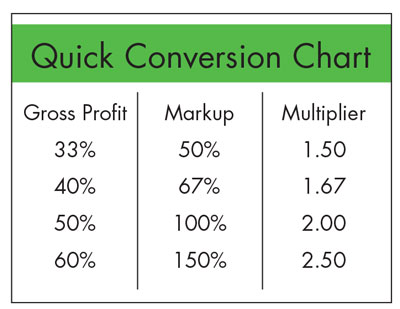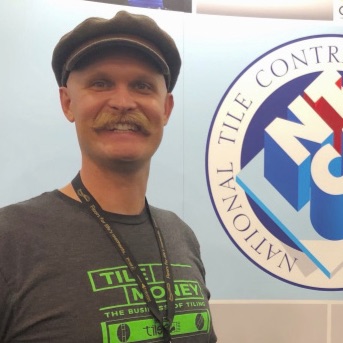The problem: underestimating time and costs
It had been dark outside for some time. My stomach was empty and delicious smells from downstairs were making my mouth water. I took solace in the fact that my loving wife was on her way, bringing a home-cooked meal to my jobsite. I would be working late tonight to meet the deadline I had promised my clients.
Once again, I had miscalculated the time it would take me to complete the tile work in this second story bathroom remodel. What’s worse than the extra time it took is that I had a sinking feeling that I had underestimated the cost of materials as well, and being who I was, those miscalculations would only affect my bank account.
Looking back on my early years of being a tile contractor, thinking about the way I priced my work – or should I say, “the way I underpriced my work” – I often wonder how I made it past year one. I suppose all those long days and unpaid weekends kept me afloat. I was always running to the next job, believing the next job would be the one where I saw a profit!
Things only got worse as the size of the jobs I was winning got larger and larger. “Look at this!” I practically shouted at my wife, “My first five-figure job; think of all the money I will take home from this one!” Months later our bank account was in a similar state, but I would fall for the trick again, “Check it out honey! I just won a job over $25,000!”
It wasn’t until my firstborn was here that I actually stopped long enough to think about what was going wrong. It was then that I knew I had to make some changes, if not for me, then for my wife and newborn daughter. How would I turn the ship around and start to estimate timeframes and job costs more accurately?
The solution: calculating direct and indirect costs
To start, I had to break free from my bad habits and learn some good ones! I had to start estimating my jobs based on my real-time history of how long it was taking me on average.
I had to learn my numbers. I had to learn what my business’s overhead was every single day. Yes, even days I wasn’t installing tile, my business was costing me money! I also learned to calculate a markup that would account for the overhead as well as profit. Because after all, if I was working that hard to just make ends meet, I might be better off working for someone else and at least have my nights and weekends free!
Every job has direct costs that are fairly simple to calculate. Direct costs are things like labor and setting materials – everything that you are paying for to get that tile installed!
What many contractors forget to calculate is their indirect costs. Miscalculating or guessing at your company’s overhead can be a grave mistake for many. Your business is alive and all living things need something to stay alive – your business needs money! Yes, even the days you are not installing tile, your business is spending money. You have to spend some time to figure out exactly how much money your business needs on a daily average. Only then can you fold that cost into what you should be charging.
As a business owner I like to pay myself the same salary every single week, whether we installed tile or not, so I consider my weekly salary as part of the business overhead since it never changes, even if I’m on a beach in Hawaii for a week.
So, how does one go about accurately estimating and pricing their tile work?
The math
Let’s use an example called Bob’s Tile Company. Bob has two employees, one installer and one apprentice. Bob pays his installer $30/hr and his apprentice $15/hr. But that combined $45 dollars winds up costing Bob’s Tile closer to $70/hr due to things like mandatory payroll taxes and worker’s compensation. Bob’s Tile also provides its employees six paid holidays a year, which is accounted for.
Bob is putting together an estimate for a job he is confident will take five days to complete. So he goes about figuring out his estimate like this.
Direct costs for the week-long job:
- Labor = $70×40=$2,800
- Materials = $1,200
Indirect costs for the week-long job:
- Company overhead = $300
- Owners salary = $1,600
That week-long job (five days) will cost Bob’s Tile Company a total of $5,900. We have yet to add in a markup percentage for profit.
As a general rule a contractor company should aim to have at LEAST a 30% Gross Profit Margin minimum.
So for the example above, Bob is going to sell the job for a 33% Gross Profit Margin, to give himself a little wiggle room. The way he calculated this math is to take his cost ($5,900) and multiply it by 50%. (See the Markup Quick Conversion chart.)
- $5,900 x 50% = $2,950. This is the job’s gross profit.
- We now have the sales price $5,900+$2,950 = $8,850.
- You can also arrive at this number using $5,900 x 1.50 = $8,850


If we want to double check the exact gross profit margin of past jobs, just divide the gross profit by the sales price.
- $2,950 / $8,850 = 0.33 x 100 = 33% gross profit margin.
Now this is a simplified example and there are some missing elements to the equation. Truth be told, you can make this as simple or as complex as you want to.
If you have loads of work, your phone never stops ringing and you hate math, you might decide to calculate for 50% gross profit which would be the cost of the job x 2. On the other hand, if you are in a very competitive market, your phone isn’t ringing much and you love math and studying, you need to buy and study the book Markup and Profit for Contractors by Michael C. Stone. (You can also listen to Michael’s interviews on the Tile Money Podcast.)
If you would like to continue this discussion, feel free to post a question or comment inside the Tile Money Facebook group.
Luke Miller hosts the industry’s first-ever business-focused Podcast called Tile Money, sponsored by the National Tile Contractors Association, LATICRETE International and Crossville, Inc. For more information, visit www.Tilemoney.com, email [email protected] or phone 831.588.0417


Luke Miller
Luke Miller founded Tile Money and launched the podcast in September 2018. With nearly 20 years of experience, Miller observed way too many skilled people working late into their nights, weekends and holidays because they failed to operate a profitable business.
Miller felt this method of operation was detrimental to the tile and stone installation industry and there had to be a better way. Driven, despite the tremendous struggle, he has developed a fundamental education body of work and presented it publicly in an entertaining way to support his colleagues in the tile and stone contractor industry.
In less than two years, Tile Money has grown to a social audience of followers across Facebook, Instagram and YouTube. Tile Money Podcasts are released in weekly episodes featuring a mix of interviews and solo episodes.







